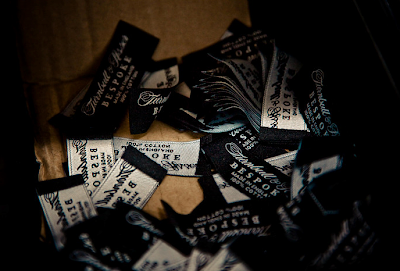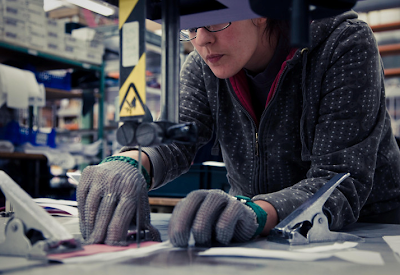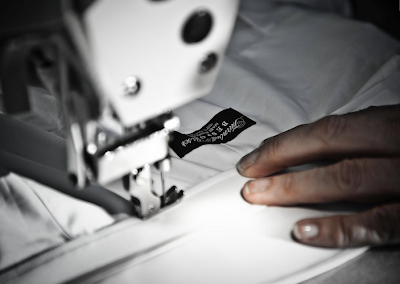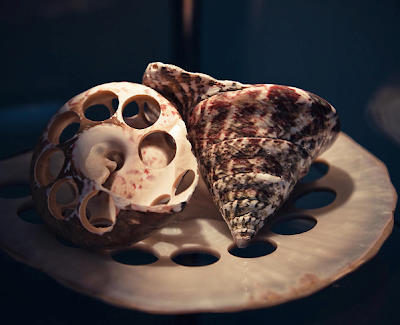
There are so many facts, figures and geeky points about the construction of Turnbull & Asser shirts that I could be writing about them for days. And you’d be reading for hours. I’ll try to keep the description of my visit brief and chronological.
When a new customer’s measurements arrive at the Gloucester factory they are entered into CAD (computer-aided design) system. David Gale’s team at Bury Street in London sends in old-fashioned paper patterns. New York sends measurements by email. There isn’t much advantage to either, but those from America certainly get to Gloucester quicker (particularly given Britain’s striking postal service).
 The paper pattern is pressed to a large plastic work table, which has copper wires running beneath the surface. A member of the CAD team then runs a “very expensive mouse” over the surface (above), clicking on every turn or corner in the edge of the pattern, completing the circuit each time and so sending a picture to the printer. This prints off a paper pattern that can be taken to cutters on the factory floor below.
The paper pattern is pressed to a large plastic work table, which has copper wires running beneath the surface. A member of the CAD team then runs a “very expensive mouse” over the surface (above), clicking on every turn or corner in the edge of the pattern, completing the circuit each time and so sending a picture to the printer. This prints off a paper pattern that can be taken to cutters on the factory floor below.Turnbull & Asser customers used to have their shirts cut from the same cardboard pattern each time. This was fine for the first two or three orders. But by the fourth and fifth time, with the cardboard taking a little nick here and a little slice there, it got ragged. This way the cutters get a fresh pattern each time.
 On to the cutting. This is mostly done with a small hand saw. The paper is slightly glued on one side, so it can be laid on the cloth and ironed on. This again is more reliable than cardboard, and the cutter can run the saw around the edge in big, long sweeps. The edges are then often finished off by hand with a pair of shears – particularly on an edge where pencil marks have been used.
On to the cutting. This is mostly done with a small hand saw. The paper is slightly glued on one side, so it can be laid on the cloth and ironed on. This again is more reliable than cardboard, and the cutter can run the saw around the edge in big, long sweeps. The edges are then often finished off by hand with a pair of shears – particularly on an edge where pencil marks have been used.[Why would there be pencil marks, I here you ask? Because one of my sleeves was half an inch shorter than the other – otherwise they were identical. So it was simpler to cut one sleeve pattern and measure off the half inch and mark it on the cloth by pencil. End of digression.]
A big band knife (above) is used for some parts of the cutting, usually for those where there is more than one identical piece of cotton to be cut. So my cuffs and sleeve gauntlets, for example, were cut on the band knife.
 [Quick additional fact: there are two band knives, one for bespoke and one for ready-to-wear. You pull the cloth through the first and push through the second. That’s because it’s easier to cut bulk when you push – and up to 50 layers of cloth are cut at a time for the ready-to-wear in the band knife. Last digression, I promise.]
[Quick additional fact: there are two band knives, one for bespoke and one for ready-to-wear. You pull the cloth through the first and push through the second. That’s because it’s easier to cut bulk when you push – and up to 50 layers of cloth are cut at a time for the ready-to-wear in the band knife. Last digression, I promise.]Next, the sewing. This is all done by hand-worked sewing machine. Some parts, such as the buttonholes, used to be sewn by hand. But T&A says the machine produces a stronger seam – and it’s still a far cry from mass production machinery. Having trained women (they nearly all are, women that is) working a sewing machine means clean lines and the ability to slow down and do difficult points with the pedal. The rounded end of the tie gap, for example.
The care and attention involved in sewing the shirt is encapsulated by the side seam. Here both front and back are folded over and the concave pushed against the convex, creating a clean French seam. That seam is then folded down and sewn onto the cloth itself. So there are four layers of cotton and three lines of sewing, all within 3/16 of an inch. It’s no wonder the women will swear by its durability.
The French seam around each part of the body does mean that there is no single seam running between the front and the tail of the shirt. So to reinforce this point, Turnbull & Asser adds a signature white octagon of cotton to create a gusset. All ready-to-wear shirts have white gussets; bespoke shirts have self-gussets.
 Finally, the buttons. While again sewn by machine, these benefit from a nifty reinforcement technique. Elasticated cotton is wound around the stalk and then fused to the thread with heat. This stands the button away from the placket and binds it together, adding greater durability.
Finally, the buttons. While again sewn by machine, these benefit from a nifty reinforcement technique. Elasticated cotton is wound around the stalk and then fused to the thread with heat. This stands the button away from the placket and binds it together, adding greater durability.[One definitely final digression: a strip of cotton canvas is fused to the back of the placket, meaning it stays crisp. The collar and collar band, on the other hand, have a floating strip of the same canvas inside.]
That’s it. A quick press, paper wrapping and the shirt is bagged up and ready to go. All Turnbull & Asser shirts go through this process, whether bespoke or ready-to-wear. That makes the construction of off-the-rack shirts a country mile better than most others. Gloucester produces around 500 of each type of shirt a month at the moment – how many factories could claim that ratio?
It should be emphasised though that Turnbull & Asser’s bespoke shirts are truly bespoke. You can change anything. One regular client has his right sleeve a little looser because he does a lot of hand-shaking. Another has different numbers of buttons on his pyjamas depending on whether they are going to his English house or the holiday home. I changed my buttons from white to black halfway round the factory. Nobody batted an eyelid.
Thank you very much to Bette, Kath and all the others in Gloucester for taking the time to walk me through this. And for putting up with my questions.

Photography: Andy Barnham




























An interesting read, albeit slightly fawning.
Do you know where do Asser source their cloth these days?
It’s worth noting the level of detail you mention is not unique to Al Fayeds shirt shop. Most bespokers do the same but lack the marketing clout.
Budd are popular amongst many who are can be trusted on such matters.
Very interesting post on the workings of the bespoke shirt factory in Gloucester.
Most customers of T&A will not have seen how their shirts are made before now.
A fascinating walk through.
This is useful for explaining to people why bespoke shirts cost what they do.
It would be fascinating to see how this shirt is doing 5 or even 10 years from now!
Hi Mr Brown,
T&A get their material from several different places, including Vanners in the UK and a few in Italy. But I’m afraid I don’t know allthe details. The one thing they will never stop reminding you though is that every pattern is unique to them.
Simon
Oh, and Budd’s methods and those of other old-school bespokers are rather different to T&A. More scissors.
But T&A is unique in the British, large-scale, handworked production in a solely-owned factory.
Hope that helps
I’ve just seen your reply, 13 years later! Yes, good points.
13 years, good grief.
Thanks for that interesting visit. Being a T&A bespoke customer I would like to add a little fact:
Even though you should be able to change every detail, unfortunately they are not very compliant when it comes to the “more difficult stuff”.
Eg: the seam which attaches the cuff to the sleeve is further away from the border than the seam finishing off the cuff on the “free” side. When I asked that both seams be equal distance from their corresponding cuff borders, they told me that it was impossible. It deceived my view of bespoke.
Simon, i’m addicted to your site. thanks for such great content. I could write for ages on shirts – my obsession – but for current purposes comment as follows. I recently “heard” -in a conversation singing the praises of Rayner and Sturgess- that T&A shirts were made by Rayner & Sturgess in Kent. Your atrticle shows that isn’t true. i also “heard” that R&S makes Emma Willis’, Dunhill’s and many other top class shirts. Do you know? What thickens the plot further is that I used to buy Dunhill’s bespoke shirts and they always had mother of pearl buttone. A recent R&S purchase didn’t. Do you think it’s a case of same workshop, different workbench?
Pgs, I can certainly confirm that the T&A shirts are made in their own factory. I know nothing about Dunhill I’m afraid, but I do know that Emma has just confirmed arrangements for buying her own shirt manufacturer. So they will be made there from now on.
Many people use R&S so I wouldn’t be surprised if Dunhill does.
Simon
Hi, I am a rather small guy (standing a little under 5’5″, about 29″ waist and 36″ chest), whilst not abnormally small it does make trousers and shirt buying rather difficult.
I have bought made-to-measure suits and jackets from Ede and Ravenscroft which are fantastic. However, I the suit is only needed about once a week so the rest of the time I prefer to wear chino style trousers and a jacket. The trouble is that I have great difficulty in discovering where I can get a good range of trousers that fit. A bespoke/made-to-measure option from somewhere like Ede and Ravenscroft is exorbitantly expensive and the option of building up a wide variety of trousers for my wardrobe is not an option there. The same holds for shirts.
Do you know where I can go to get trousers and shirts made-to-measure, that are of a good enough quality for daily use but that don’t cost an absolute fortune?
Many thanks.
Hi DDJ, I’m afraid made to measure trousers and shirts are something I have never bought. The first always RTW and the second bespoke.
Simon
For pgs – R&S shirts are made in Kent at their own factory. The default R&S buttons ARE mother-of-pearl, but each company that they make for is free to use their own buttons.
Dunhill do possibly use TR&S, as when David Gale left Dunhill, i put Dunhill in touch with R&S as they were looking to outsource to R&S.
Simon, where in Gloucester is the T&A factory?
I have some T&A RTW shirts that are clearly different from the Gloucester default line with noticeable differences in collar band construction and side/sleeve seams (ie two rows stitching on inside not outside and slightly wider apart) which could be R&S.
I would like to buy my husband a visit to the dunhill factory in walthamstow as he is really into his pipes. Does anyone know how I would go about that as all I can find is peoples write ups on there visit but no info on how to arrange a visit?
Thanks
Hi – There are no official tours of the factory, but I’m sure something could be arranged. I recommend you contact Joanna Christie in the marketing department at Dunhill.
Simon
Thank you very much Simon I will do that. Do you know if there is a shop aswell so we could maybe add a new Dunhill to his collection?
Thanks
Greta
No there is not Greta – it is not really fitted out for visitors in that way.
Simon
Dear Simon,
Great blog you have here. I’m getting addicted to your post! I really do appreciate the handfull of gentlemen who still do care about the details of their clothing.
my two pence:
recently had 6 shirts made in T&A. measured by David Gale – great guy, funny and smells like he ate cigar for lunch. Price starts from £195 each (most basic, cotton). All fabrics used are from Italy, not England anymore.
Before stepping into T&A, I was very tempted to get my shirts done in New & Lingwood – I love their collars. Whether who is the best, I’m yet to find out. Will post a review once I had my fittings done.
Cheers
J
Fascinating. Thanks.
hi simon ive been perusing your back posts on T&A as i know quite a bit about their shirt making facilities (largely due to your fantastic write ups) but almost nothing about the tailoring side of their business. i have seen some nice suits displayed in the shops & there is the belief that the POW wears MTM T&A suits (in recent years), yet there is no information on the subject on their web.
do you know if they make suits and so on in the glostershire factory or if they outsource this to someone else? if so is it british made since they seem to favour british made elsewhere?
Andrew
Hi Andrew,
They only do made to measure and it is outsourced. To Cheshire Bespoke in the UK I believe – it certainly used to be. I’m afraid I haven’t had anything made so can’t make any form of recommendation.
I don’t know where the Prince Charles information comes from, but there are certainly a good few basted suits going through A&S still.
Simon
thanks for the info simon, much appreciated.
no idea if its true but had heard it bandied about on various articles ..
A
Simon, for those of us that have been there and done that with English shirt makers, and have not had a good experience can you do some research in Italian or French bespoke or even MTM.
I had tried T&A for years but there cloth and fitting have never been as good as the Italian MTM I use now. Problem is that the Italian one I use is quite expensive. There must be dozens of small shirt makers spread around Naples and Milan that make beautiful shirts.
I’m surprised everyone on this blog is so positive about English shirts makers, in my experience, they always fit like parachutes (yes even the bespoke) their fabric creases the moment ou put it on, and sleeves are very wide.
I see you have written about Kiton, but they are very expensive and commercial, where are al the hidden artisans ????
I couldn’t agree more, three years after this post. My favourite is Satriano Cinque in Naples. About to do a post on them, plus Burgos in Spain, and an Italian MTM
Prey what is the name of the Italian MTM?
It’s being done through Segun Adelaja, who owns a boutique in the Royal Arcade. He designs his own collar shapes etc, but it all goes through an Italian factory. Not that cheap though – starts at £240 I think. Most with a shop in London are that much more expensive.
The ideal is to have a small Italian maker, go there once or twice to get the pattern right, and then do all further ordering remotely, to keep costs down. Hopefully that’s what I’ve found with Satriano
Hi, yep I agree. I actually know Segun’s boutique and I have gone in there and spoken with him a couple of times. His prices seem astronomical for MTM and tbh you are paying his margins. I pay around $190 for a very good MTM through my Italian tailor in London (who btw does the most wonderful suits for me from Castangia) yet I still feel those shirts are too expensive, hence my search for a new source.
I have come across a factory in Twickenham that makes a lot of the dressing gowns and shirts for some of the best names in Jermyn St and I have got them to copy the patterns from one of my shirts and waiting to see the results of that experiment. Let me know if you want more details, would be happy to share them. He is also making me a MTM dressing gown for me in a rich poplin in Light grey with white piping.
sounds interesting, do contact me, email address simon at simoncrompton.co.uk
I purchased two beautifully patterned T&A shirts during a sale last year. I subsequently noticed that the sleeve and body patterns were not matched on the shoulder, which I believe is standard for a high quality shirt maker such as Turnbull and Asser. Is there a lesser attention to detail for RTW on-sale items or am i expecting too much in a sale item ?
It won’t be RTW or the fact that it’s on sale. It’s more that T&A doesn’t necessarily think that’s that important. English and European shirt makers have a very different attitude to details like this
Thank you Simon
Hello, I’m curious whether you think the price difference between a Turnbull shirt and, say, a Hilditch and Key shirt is justified in the difference in quality. To my mind H&K claim to do many of the things you describe T&A doing in their rtw (some hand stitching, unfused collar lining, MoP buttons etc). Is part of the price difference due to quality of material also? Is part of it simply savvy branding and product positioning? On that note, I’m curious to know what you think about Thomas Pink, which is undoubtedly a very brand-oriented global shop. I can’t imagine its prices are justified by superior quality. Or am I getting it all wrong?
Thank you!
Hey,
There won’t be much in the making, no. It’s largely down to quality of materials, branding as you say, and then perhaps some consistency of quality.
Simon